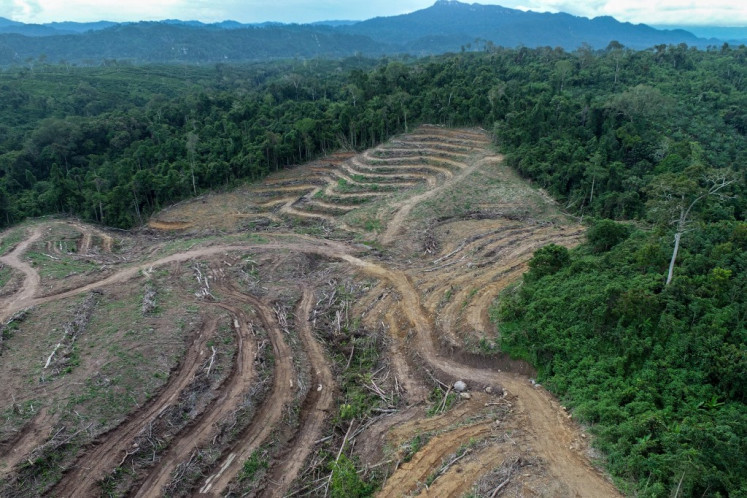Popular Reads
Top Results
Can't find what you're looking for?
View all search resultsPopular Reads
Top Results
Can't find what you're looking for?
View all search resultsThe inconvenient truth about Indonesian deforestation
Recently, the Forestry Minstry issued Ministerial Decree No
Change text size
Gift Premium Articles
to Anyone
R
ecently, the Forestry Minstry issued Ministerial Decree No. 633/2014, which determines Indonesia's forest reference emission level (FREL). According to the decree, the reference emission level to calculate the reduction of greenhouse gas (GHG) emissions in the forestry sector in Indonesia is 0.816 billion tons (gigatons ' gt). When actual emissions are lower than the reference level, emissions are reduced.
Indonesia is committed to reducing GHG emissions to 26 percent unilaterally or 41 percent with foreign assistance from their business-as-usual levels by 2020.
An overwhelming portion of the reduction is expected to take place in the forestry and land use-related sectors, mainly through Reducing Emissions from Deforestation and Forest Degradation (REDD+).
The decree claims this figure comes from average forest emissions in the period of 2000-2006, and 'from the projection of forest emissions to be used in the development outside of forestry activities until 2020'. Despite the significance of the FREL in the context of national emission reduction, the decree seems to approach this matter in a rather low-key way as it does not elaborate on where the figure comes from, or how it corresponds to the level of deforestation.
As Indonesia embarks on the next phase in the national implementation of REDD+ amid public debate over continuing deforestation and forest fires in the trouble-prone provinces of Riau and West Kalimantan, prominent questions arise, such as: What is the actual rate of the country's deforestation despite the ministerial decree?
The question is not so easy to answer, even scientifically. Politics makes it even more complicated. Not long ago, mongabay.com, citing a study published in Nature Climate Change by Belinda Margono et al (2014) from the University of Maryland (UMD), said Indonesia had become the world's largest deforester.
The study, using high-resolution satellite data, shows that Indonesia lost 15.8 million hectares of forests between 2000 and 2012 ' 6 million ha or 38 percent of which are in intact and degraded natural forests. The rate hit its highest level in 2012, the lat year in the study, at about 850,000 ha, with an upward trend.
Meanwhile, the Forestry Ministry reported this year that deforestation of primary and secondary forests was estimated to be about 628,000 ha (24,500 ha of primary forests and 603,500 ha of secondary forests, which are believed to be similar to, if not the same as 'intact' and 'degraded primary' forests, according to Margono et al) between 2011 and 2012.
_________________
A satellite imagery-based interpretation usually captures gross, not net, deforestation, as it also captures forest regrowth.
This is higher than the deforestation of around 400,000 ha between 2009 and 2011 as reported by the ministry in 2012, but lower than the 1.1 million ha reported in the Second National Communication to the United Nations Framework Convention on Climate Change (UNFCCC) for the 2000-2005 period (2010). The ministry claims deforestation is showing a downward trend.
Which number is the correct one? To understand this, it is useful to understand how the same deforestation data may yield different interpretations, conclusions and lead to different policy implications.
First, accuracy and interpretation matter. The UMD uses digital interpretation, whereas the Forestry Ministry uses visual classification methods, based on satellite imagery from Landsat 5, 7, and LDCM (Landsat 8) into 23 land cover classifications. This method was used by the ministry from 2000 to 2012. For both figures, an accuracy assessment needs to be done.
Once accuracy has been confirmed, then it is down to interpretation. Digital interpretation is faster, while a visual method runs the risk of human error. Satellite imagery, after all, is a picture of the Earth from above. It is the users that interpret the picture according to set definitions.
Additionally, a satellite imagery-based interpretation usually captures gross, not net, deforestation, as it inevitably also captures forest regrowth.
Second is definition. What constitutes a forest and how forests are classified will determine what constitutes deforestation.
For example, defining forests as vegetative cover with 30 percent canopy will yield different areas of forests and different deforestation pictures from an area with 10 percent canopy. However, with 30 percent canopy, rubber plantations may be considered forests.
Specifically in Indonesia, there is a policy-based definition. The Forestry Ministry works according to a jurisdictional definition of forests that may be smaller than the actual forest cover in the country.
The deforestation figure, therefore, may be limited to that within the forest estate boundary, discounting that outside it.
So, what can be done to allow for a unified deforestation figure in Indonesia? The Presidential Working Unit for the Supervision and Management of Development (UKP4) hosted two roundtables to address this very issue in early 2013 and 2014.
Key messages from the roundtables included the following. First, the different figures are recognized as the result of, among other things, definitional and methodological differences.
Second, there is a need for data-source transparency to achieve consistency, integrity and accountability. With the same data set, anybody should be able to recreate the conclusions produced by particular methodologies.
For this, there was a recommendation to compare the maps managed by the Forestry Ministry and the UMD, as well as to adopt other available products (such as those produced by the Indonesian National Carbon Accounting System) to come up with solid forestry data sets to be maintained with the involvement of regional governments to act as the custodians of local forest data and local universities.
The UKP4 has been asked to continue in a facilitative role, while technological support is provided by able and concerned parties, such as Google and Global Forest Watch. The REDD+ Management Agency (BP REDD+), meanwhile, is also facilitating the transparency of data and information.
Third, there is a need to approach the definitional issue simply by concentrating on the remaining natural forest. The immediate priority is gross deforestation of natural forest. Based on the simple approach, a basic data set for the calculation of the FREL needs to be proposed transparently.
This approach should also review the current deforestation calculation process adopted in the draft of the Indonesian national standards of changes to land cover. Eventually, these steps will aim to adhere with Indonesia's emission reduction commitments using credible methods.
Fourth, since there is no regulation that authorizes a specific government institution to issue an Indonesian FREL, it has been agreed among the participants that all institutions must support any relevant institution that volunteers to propose an Indonesian FREL.
While the FREL should be developed empirically following methodological guidance from the UNFCCC and REDD+, the volunteering institution must conceive its proposal through transparent, collaborative and inclusive processes.
Finally, an enabling environment needs to be fostered as a means to enhance transparency and improve governance.
How will the Indonesian FREL come into being? What is the actual rate of the country's deforestation? It is indeed a technical, rather than a political, question.
________________
Agus P. Sari is deputy chair of Reducing Emissions from Deforestation and Forest Degradation (REDD+) Management Agency. Nirartha Samadhi is deputy chair of the Presidential Working Unit for the Supervision and Management of Development (UKP4). The opinions expressed are their own.










